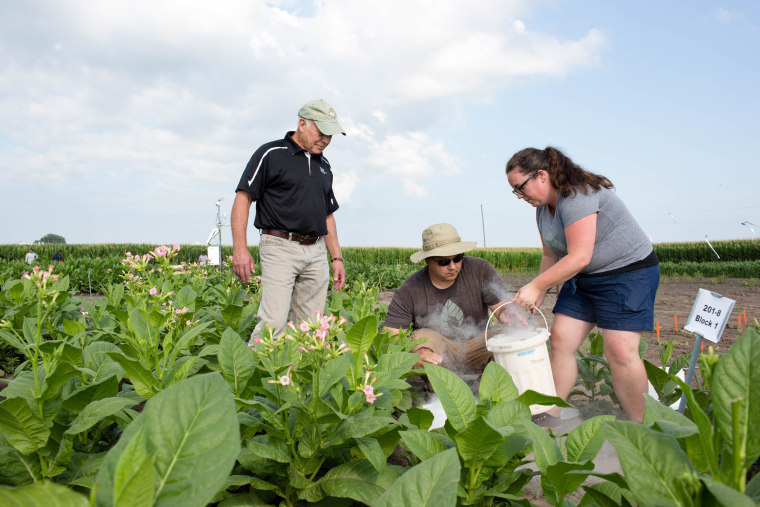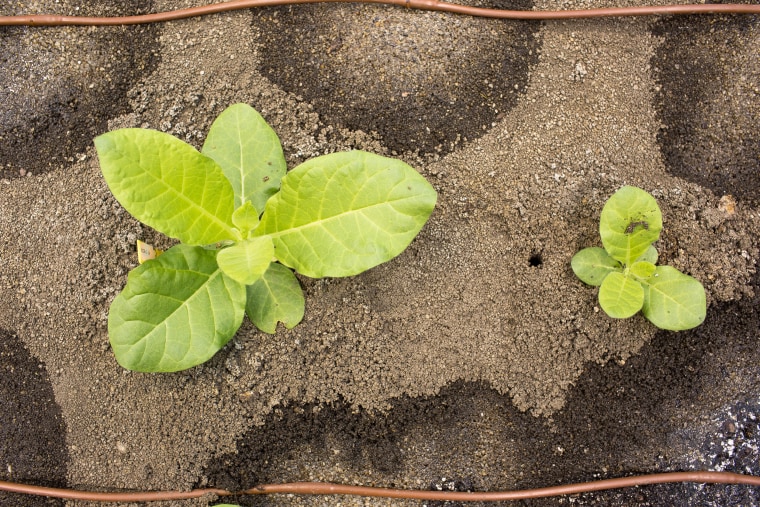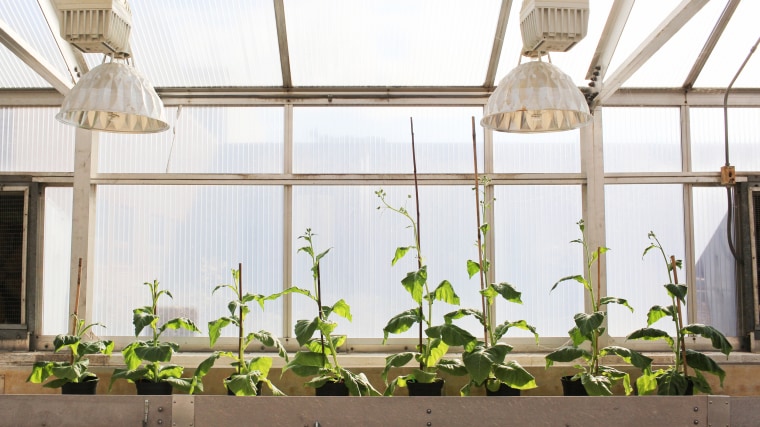Plant scientists have found a way to 'hack' photosynthesis. Here's why that's a big deal

Scientists at the University of Illinois reprogrammed plants to boost their ability to convert sunlight into the fuel they need to grow.Claire Benjamin / RIPE project
Humans owe a lot to photosynthesis, the process by which green plants turn water and carbon dioxide into the food we eat and the air we breathe. But this 3.5-billion-year-old biochemical process is woefully inefficient — at least in its natural state.
Now scientists have found a way to "hack" photosynthesis, using genetic engineering techniques to reprogram plants' biochemical machinery to enable them to grow bigger and faster.
In a series of experiments at the University of Illinois, the genetically modified tobacco plants grew up to 40 percent bigger than ordinary tobacco plants. If the same kind of tweak can work for food crops like wheat and soybeans, the scientists say, it could help farmers around the world produce enough food to sustain a growing global population.

Using genetic engineering, scientists were able to boost the growth of tobacco plants by up to 40 percent. Credit: Claire Benjamin/RIPE
“By 2050, we’re pretty certain that we have to increase crop yields by anywhere from 25 to 70 percent to feed all the hungry people in the world,” said Amanda Cavanagh, a postdoctoral researcher at the university and co-author of a new paper describing the research. “We don’t have another obvious way to increase yield other than taking a genetic engineering approach.”
To create the reprogrammed plants, Cavanagh and her colleagues zeroed in on RuBisCO, an enzyme plants use to capture carbon dioxide from the air and convert it into stems, leaves, roots, and other plant matter.
RuBisCO evolved about 3.5 billion years ago, at a time when there was no oxygen in the atmosphere. As a result, it's not particularly good at discriminating between carbon dioxide and oxygen. Sometimes it latches onto a molecule of oxygen rather than carbon dioxide.
"This is essentially anti-photosynthesis, and the plant produces a toxic compound that it has to recycle and detoxify," said Donald Ort, a plant biologist at the University of Illinois and the study’s senior author. The detoxification process requires plants to expend a lot of energy, meaning they have less to devote to growth.
The scientists didn't modify the enzyme but changed the plants' DNA by inserting genes that simplify and speed up the detoxification process. As a result of the modification, the plants were able to grow bigger and more rapidly — a result is seen in plants grown in the field as well as in greenhouses.
 Four unmodified plants (left) grow beside four plants (right) that were genetically engineered to make the process of photosynthesis more efficient. Credit: Claire Benjamin/RIPE
Four unmodified plants (left) grow beside four plants (right) that were genetically engineered to make the process of photosynthesis more efficient. Credit: Claire Benjamin/RIPE
The scientists worked initially with tobacco plants because they grow quickly and have genes that are easy to manipulate, Ort said. Now they're trying out their technique on potatoes, soybeans, and cowpeas.
It’s too soon to know if these modifications have any drawbacks, but Ort said any enhanced crops would undergo rigorous testing before they are ever consumed by humans.
Robert Blankenship, a biochemist at Washington University in St. Louis who wasn't involved with the research, called the results “impressive” and said the Illinois scientists' feat is a major advance.
“There are several approaches that people are using to improve the efficiency of photosynthesis, but I think this is one of the most promising and potentially beneficial,” he said. “There could be important benefits in areas of the world that have food security problems.”
By: Denise Chow || NBC News MACH
RELATED RIPE OBJECTIVES
Photorespiratory Bypass